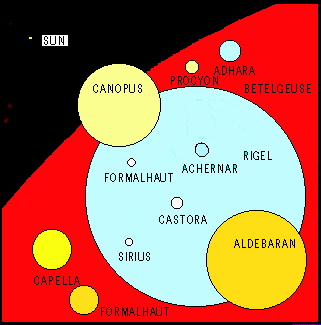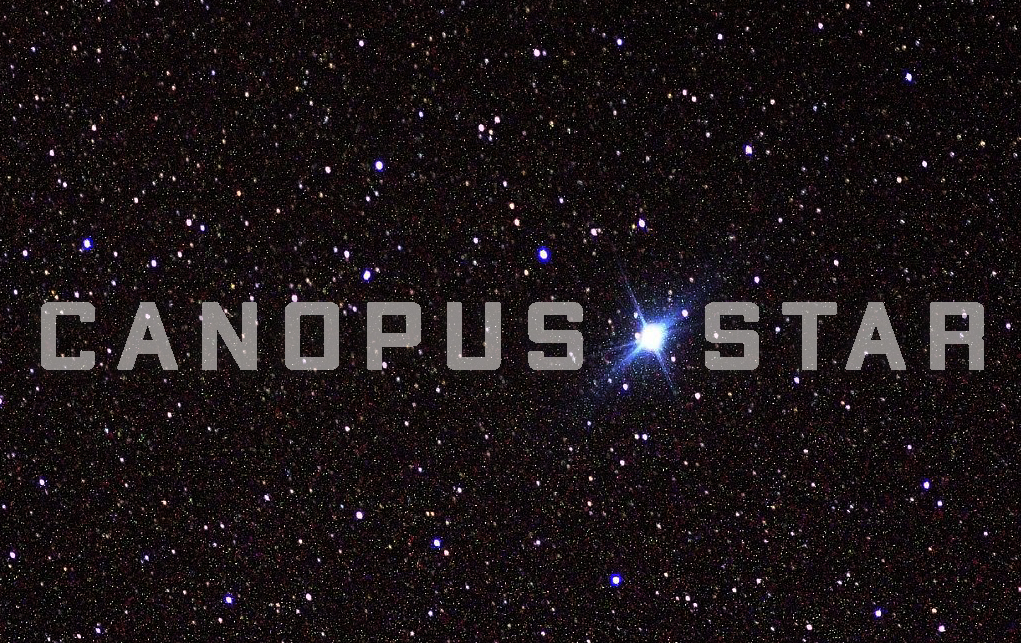Location and Distance
The Canopus star is located in the constellation of Carina, around 310 light years away from Earth. It lies too far south and can’t be seen north of latitude 37°18’N, but it is circumpolar for observers south of lati-tude 37°18’S. For northern observers, Canopus doesn’t rise very high in the sky.
Observers in northern latitudes south of 37°N can find the star below Sirius in the southern sky on winter evenings. It is located about 36 degrees to the south of Sirius. For southern hemisphere ob-servers, Canopus and Sirius reach the meridian only 21 minutes apart and can be seen in the sky at the same time.
It culminates at 9 pm on February 11 and at midnight on December 27. Its right ascension is 06h 23m 57.10988s and its declination is −52° 41′ 44.3810″.
Canopus is a member of the Scorpius-Centaurus Association, which is the nearest OB association to the Solar System. Other members include Antares, most of the stars that form the Southern Cross, and a number of bright stars in the constellations Centaurus, Crux, Lupus and Scorpius.
Canopus is also used in space navigation to adjust the position of spacecraft in space. Many space-craft are equipped with a special camera called the Canopus Star Tracker.
Star System, Size and Composition

Canopus is a bright giant of spectral type A9, so it is essentially white when seen with the naked eye. It has the stellar classification F0 II or F0 Ib, which means that the star is a less luminous supergiant. It may be evolving into a red giant or away from red giant status.
The stair is fairly large in size and has a radius that is 71.4 times that of the Sun and has around 9 solar masses. It also has an estimated surface temperature of 7,350 K, making it significantly hotter than the Sun.
Canopus is the the most intrinsically bright star within 700 light years of the Solar System, thanks to its absolute magnitude of -5.53 and 15,100 solar luminosities. This also means it is brighter than Sirius, although Sirius is much closer to us (8.6 light years) and appears twice as bright as Canopus.
Canopus is moving through the Milky Way Galaxy at a speed of 24.5 km/s relative to the Sun. The star’s projected galactic orbit takes it between 21,300 and 24,300 light years from the galaxy’s centre.
The star is also a strong source of X-rays, which are likely produced by the star’s corona. The corona is magnetically heated to approximately 15 million K.
History
The origin of Canopus is not fully known. It is thought that the star was named after Canopus, the pilot of the ship on which Menelaus sailed to retrieve Helen of Troy after she was kidnapped by Par-is. When Menelaus’ ship arrived in Egypt in 1183 BC after the destruction of Troy, Canopus was bit-ten by a snake and died. To honour him, Menelaus founded a port there and named it Canopus, and gave the name to the bright star that rose when he was giving the dedicatory speech.
English explorer Robert Hues brought Canopus to the attention of European observers, writing about the star in his work Tractatus de Globis (1592).
Ancient Greeks and Romans could not see Canopus. However, the constellation Carina was once part of a larger constellation, the Argo Navis. This represented the ship of Jason and the Argonauts, with Canopus marking the ship’s rudder or keel. The ship Argo Navis was later divided into three smaller constellations: Carina (the Keel), Puppis (the Stern) and Vela (the Sails).
The distance of Canopus from Earth was uncertain until the 1990s, when the European Space Agency launched the Hipparcos satellite. This was partly because the star has an unusual nature, one not yet fully understood by astronomers.
Alpha Carinae made its closest approach to the Sun 3.1 million years ago. At this time it came within 172 light years, brightening to magnitude -1.88.
Future
Canopus will likely end its life by expelling its mass to form a planetary nebula. Leaving behind a white dwarf when it does. It is not large enough to explode as a supernova.
IMAGE SOURCES:
- Canopus Star image – By NASA – Public Domain, https://commons.wikimedia.org/w/index.php?curid=2158924
- Canopus size comp – https://people.highline.edu/iglozman/classes/astronotes/media/betel_sizecomp.gif
